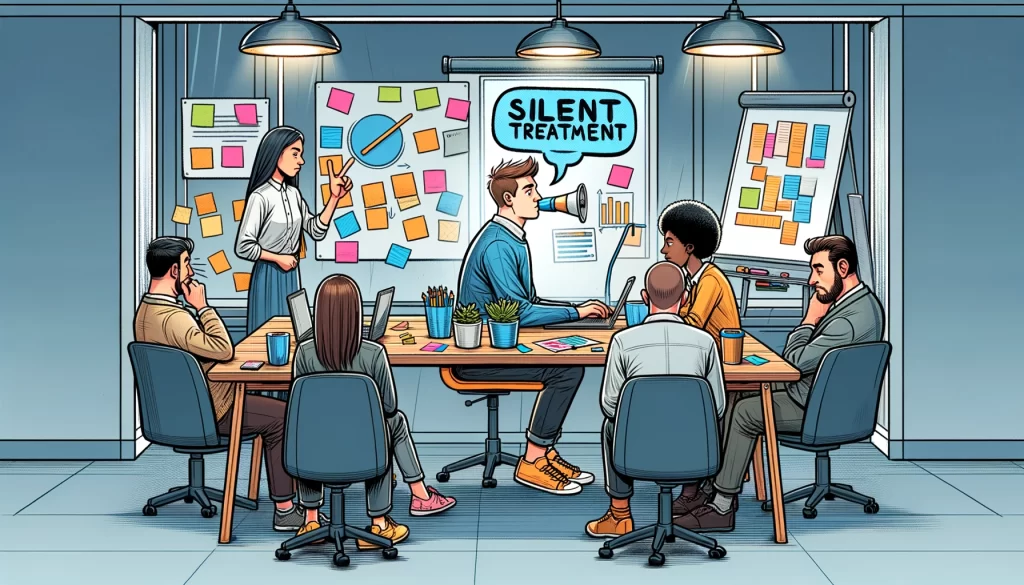Have you ever felt the sting of silence in a workplace conversation?
The silent treatment, a pervasive form of non-verbal communication, can transform a vibrant office into a toxic environment, silently but effectively.

It’s more than just the absence of words; it’s a tool for control, exclusion, and power play.
In this article, we delve into the world of silent treatment at work – its types, psychological underpinnings, and the corrosive impact it can have on mental health, professional relationships, and personal well-being.
Get ready to explore strategies to combat this silent but potent workplace challenge.
Key Takeaways
- Understanding Types and Causes: Recognize various forms of silent treatment – ostracism, exclusion, isolation – and their underlying motives, such as control, punishment, and manipulation.
- Psychological Impact: Be aware of the significant mental and emotional health repercussions, including feelings of vulnerability, isolation, and stress.
- Workplace Consequences: Understand how silent treatment undermines job satisfaction, hinders communication, and affects overall team dynamics and innovation.
- Personal Relationship Toll: Acknowledge the negative impact on personal relationships, eroding trust and open communication.
- Effective Strategies: Learn strategies to address silent treatment, including developing effective communication skills, setting boundaries, and seeking professional help when necessary.
Strategies to Address the Silent Treatment
In dealing with the silent treatment at work, it’s crucial to apply specific strategies that facilitate open communication, establish boundaries, and potentially involve assistance from professionals.
- Development of Effective Communication Skills
- Cultivate active listening skills.
- Use “I” statements to express feelings without blame. Example: “I feel excluded when I’m not acknowledged in meetings.”
- Learn to articulate needs clearly and assertively.
- Setting Boundaries and Seeking Support
- Set boundaries to maintain self-esteem. Example: “Let’s talk when you’re ready to communicate openly.”
- Seek support from trusted coworkers.
- In severe cases, consider contacting the National Domestic Violence Hotline for guidance.
- When to Consider Professional Help
- Consult a mental health professional if the silent treatment significantly impacts mental health or if conflict persists.
- Use counseling or therapy for strategies to manage emotions, anger, forgiveness, and apologizing.
- Consider a third-party mediator or therapist for systemic workplace issues.
Understanding the Silent Treatment
The silent treatment at work is a form of non-verbal communication that can create a toxic environment.
Recognizing its types and understanding the psychological mechanisms driving this behavior are crucial for addressing it effectively.
| Scenario at Work | Type of Silent Treatment | Possible Cause |
|---|---|---|
| Colleague not acknowledging presence | Ostracism | Desire for control or power, non-confrontational expression of displeasure |
| Being left out of conversations/meetings | Exclusion | Punishment, asserting dominance |
| No response to emails and messages | Isolation | Control, creating emotional distance |
| Skipped over for important updates | Exclusion | Manipulation, asserting authority |
| Physical distancing in the workplace | Isolation | Intentional emotional harm, power dynamics |
This table helps in identifying the type of silent treatment and its underlying causes in a professional setting, facilitating a better understanding and approach towards addressing such situations.

This study highlights that a significant portion of individuals feel excluded in their social environments, with ostracism being identified as being excluded and ignored by individuals or groups.
This phenomenon is particularly relevant in the workplace, where it can lead to distressing effects on individuals.
Types and Manifestations
The silent treatment manifests in various forms, ranging from intentional ignoring to outright exclusion from communications.
At work, it might look like a colleague refusing to acknowledge another’s presence, skipping over someone when sharing important updates, or failing to respond to emails and messages.
Such behavior is often used as a form of punishment or control, where the individual giving the silent treatment aims to exercise power over the recipient.
- Ostracism: Social exclusion from a group.
- Exclusion: Intentionally leaving someone out of conversations or meetings.
- Isolation: Creating physical or emotional distance.
Whatever the form it takes, the silent treatment can lead to feelings of frustration and helplessness, making it a potent form of emotional abuse when used manipulatively.
Psychology Behind Silence as Punishment
When silence is used as punishment, it often stems from a desire for control or power over another person.
Individuals who engage in this abusive behavior may believe it offers them a non-confrontational way to express displeasure or assert dominance.
As a method of manipulation, it can leave the target feeling powerless and seeking the approval of the one who is administering the silent treatment.
Psychologically, being on the receiving end of silent treatment can lead to:
- An increased sense of vulnerability.
- Doubts about one’s own perceptions and feelings.
Recognizing these dynamics is vital for both the individuals involved and the organizations that wish to foster a healthy workplace free from silent treatment abuse.
The Impact of Silent Treatment
- Corrosive Effects: The silent treatment negatively impacts work environments, personal well-being, and professional relationships.
- Multi-faceted Effects: Affects mental and emotional health, disrupts professional settings, and has consequences in personal relationships.
The silent treatment can corrode work environments, personal well-being, and professional relationships through its multifaceted effects on mental and emotional health, its disruption in professional settings, and the resulting consequences in personal relationships.
Effects on Mental and Emotional Health
- Negative Outcomes: Can lead to emotional pain, depression, and loneliness.
- Long-term Consequences: Ongoing exposure may result in considerable stress and potential long-term trauma.
When individuals are subjected to the silent treatment, they may experience a range of negative mental health outcomes.
It can lead to feelings of emotional pain and exacerbate conditions like depression and loneliness.
Psychology professionals recognize that ongoing exposure to this form of non-communication can create considerable stress, potentially leading to long-term trauma.

Silent Treatment in Professional Settings
- Impact on Work Environment:
- Undermines Belonging: Makes the recipient feel isolated and less part of the team.
- Reduces Job Satisfaction: Affects overall contentment and fulfillment at work.
- Hinders Communication: Impedes effective interaction, crucial for a healthy work atmosphere.
- Organizational Consequences: May lead to reduced collaboration and innovation.
In a workplace, a boss or colleague giving the silent treatment can have severe repercussions.
This behavior can undermine the recipient’s sense of belonging, impact job satisfaction, and hinder effective communication – a cornerstone of a healthy workplace atmosphere.
Organizations may note a decline in collaboration and innovation due to the strained relationships this abusive tactic creates.
Consequences in Personal Relationships
- Impact Beyond Work:
- Family Dynamics: Can be damaging in familial settings.
- Romantic Relationships: Often seen as an abusive action.
- Erosion of Trust: Impedes open communication, fosters resentment, and erodes the foundation of healthy relationships.
Beyond the professional realm, silent treatment markedly impacts personal relationships.
Whether in family dynamics or romantic relationships, giving someone the silent treatment is often considered an abusive action.
One study reveals that the primary reasons individuals give the silent treatment include feelings of hurt, anger, and frustration.
These emotions often stem from unmet expectations within close relationships, highlighting the emotional complexity behind the use of silent treatment.
It deteriorates the foundation of healthy relationships by impeding open communication, fostering resentment, and eroding trust.
Conclusion
Understanding the silent treatment at work is more than just recognizing a lack of words; it’s about seeing the underlying control, manipulation, and impact on mental health and relationships.
This non-verbal behavior speaks volumes, affecting everything from personal well-being to professional dynamics.

But remember, we have the power to change the narrative.
By fostering open communication, setting boundaries, and seeking help when needed, we can transform silence into dialogue.
So, let’s not just break the silence; let’s start a conversation that echoes change.
Share this insight, discuss it with peers, and remember, in the harmony of many voices, no single voice remains unheard.

Daniel Boyce, founder of AwareRecruiter.com, brings a diverse background in health, fitness, sales, and recruitment to career development. He’s passionate about helping professionals overcome workplace challenges and succeed in new roles. Daniel’s vision for AwareRecruiter.com is to create a comprehensive resource for career growth and satisfaction.

